 <><>
<><>
 <><>
<><>
During the First World War, the Dutchman Anthony Fokker was building airplanes in Germany. His first factory called Fokker-Flugzeugwerke was located at the Johannisthal airfield, near Berlin. In 1913 he moved to Schwerin. A lot of different types were designed and built there, among which were the famous ‘Eindecker’ series, and the Dr.1 triplane made famous by the leading ace of WWI credited with 80 victories, Manfred von Richthofen, the “Red Baron”.
In the early part of 1917 the Sopwith Triplane of the Allies began appearing on the battlefield, quickly trouncing German Albatros D.III fighters with its superior maneuverability and climbing ability. The Idfleig, the German bureau overseeing aircraft design immediately ordered development of a triplane, known as dreidecker (3 winged) in German.
The first prototype Dr.1 flew in July of 1917 and production commenced on August 11th of 1917. In preproduction the triplane carried the designation F.1. Two were made and issued to Richthofen and Leutnant Werner Voss. These two aces promptly used these planes on the battlefield, scoring kills within the first few days of flying in early September. Voss took to the skies on August 28th and by September 11th had scored 8 kills.
The result of this evaluation period led Voss and Richthofen to recommend the Dr.1 for production as soon as possible, declaring it superior to the Sopwith Triplane. Orders were placed for 300 Dr.1’s.
On September 14th the commander of Jasta 11, Oberleutnant Kurt Wolff was shot down while flying Richthofen’s F.1 by a new Sopwith Camel of Britain’s Naval 10 squadron. Voss, while flying on September 23rd scored his 48th victory just before being shot down in an epic dogfight wherein he managed to damage all 7 of his opponent’s SE-5a’s in the skirmish.
The Dr.1, upon its arrival to the battlefield in October was well regarded for its climbing ability and light controls. The ailerons were not very effective, however the tailplane elevator and rudder controls were very yielding. Rapid turns to the right were very quick thanks to the directional instability afforded by the rotation of the rotary engine, a characteristic that was taken advantage of by pilots.
Although not a particularly fast plane, it balanced this shortcoming with great maneuverability thanks to its light weight, while also having good upward visibility. It also had a decent climb rate, characteristics that all seemingly made the Dr.1 a formidable adversary to its Allied opponent, the Sopwith Camel. This made of the Dr.1 a good aircraft for dogfights, yet structural and construction problems in the wings would hamper the aircraft’s promising initial assessment.
The Dr.1 was armed with twin 7.92mm Spandau machine guns, which could fire simultaneously or independently in synchronization with the propeller. The rotary engine and fixed propeller rotated together.
The Dr.1, for all its improvements over previous German aircraft, had numerous shortcomings. Among them was its tendency to ground looping upon landing. This occurs when the aircraft tilts on landing such that one wing makes contact with the ground. For this reason skids were attached to the wingtips of the lower wing on the production version. Also while the Dr.1 had excellent climbing ability, its dive and level flight speed were less than desirable, leaving it vulnerable to faster Allied planes in many situations.
Following the proper introduction of the production model Dr.1 in October, by the end of the month two consecutive top wing failure accidents promptly caused all triplanes to be grounded. The wing structure of the Dr.1 was thoroughly investigated and numerous problems were discovered, the first of which was weak attachment of wingtips, ailerons, and ribs. Further, the doping of the fabric and wood varnishing was found to be of poor and inconsistent quality, leading to water absorption and premature rot in crucial wing spars.
Fokker’s corrective action was to improve quality control on the production line, as well as modifying and repairing existing models. The problem was believed to have been solved, and the Dr.1 continued to see use well into 1918, but later the wing failures returned.
As had been seen in September 1917, the Dr.1 was inferior to the capabilities of the British Sopwith Camel by the time production had commenced. Despite this, German production went on for the initial 300 ordered.
Manfred von Richthofen achieved 19 of his last 80 victories in the Fokker Dr.1. On von Richthofen’s last day, the front lines had been in flux, and he found himself chasing a Sopwith Camel at low level over enemy territory. Although there are many stories about his death, it is generally accepted that he was killed by one anti-aircraft bullet from the ground. The British buried Richthofen with full military honors.
Facts and General Characteristics of the Fokker Dr.1:
Contractor: Fokker-Flugzeugwerke, Germany
Type: Fighter
Crew: One
Upper Wingspan: 23 ft. 7 in. (7.19 m)
Length: 18 ft. 11 in. (5.77 m)
Height: 9 ft. 8 in. (2.95 m)
Weight: Empty 895 lbs. (406 kg), Gross 1,291 lbs. (586 kg)
Power Plant: 1 × Oberursel Ur.II 9-cylinder air-cooled rotary piston engine, 82 kW (110 hp)
Max Speed: 110 mph (180 km/h) at 2,600 m
Range: 190 miles (300 km)
Ceiling: 20,000 ft. (6,000 m)
Armament: 2 × 7.92 mm (0.312 in) Maschinengewehr 08 "Spandau" machine guns.
Facts and General Characteristics of the Model:
The model represents the Fokker Dr.1 1425.17 flown by Captain Manfred von Richthofen, commanding officer of Jasta 11 Jagdgeschwader 1 (JG 1) in 1918. JG 1 became known as "The Flying Circus" (German: Der Fliegende Zirkus) or "Richthofen's Circus" because of the bright colors of its aircraft, and perhaps also because of the way the unit was transferred from one area of Allied air activity to another – moving like a travelling circus in trains, and frequently setting up in tents on improvised airfields.
Manufacturer: DML, Hong Kong
Scale: 1/48
Wingspan: 5.8”
Length: 4.5”
Height: 2.5”
Parts: 77 including photo-etched metal and support wires
Decals: 23
Hours to build and paint: 24.4
Mistakes/Problems:
1. I broke the left upper wing spar.
2. I lost the pilot step and had to manufacture one from wire.
3. Tiny photo-etched metal and plastic parts were extremely hard to pick up and glue in place – dropped parts many times.
4. Very difficult to get the top wing to line up properly.
5. Machine guns very difficult to line up properly.
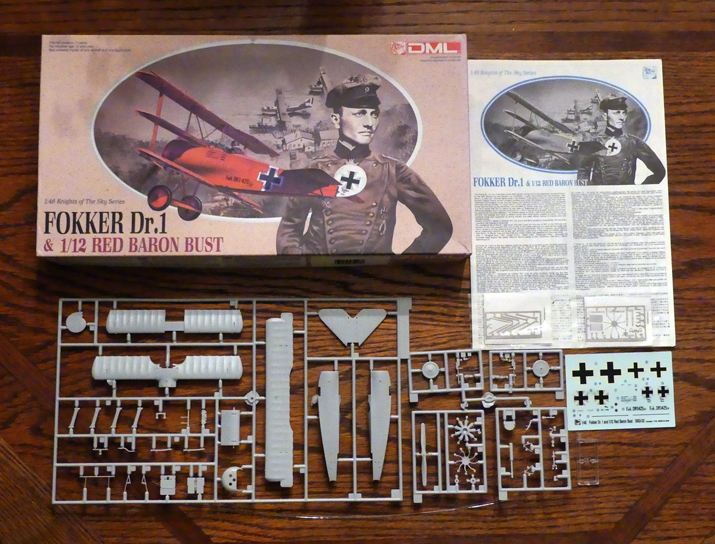

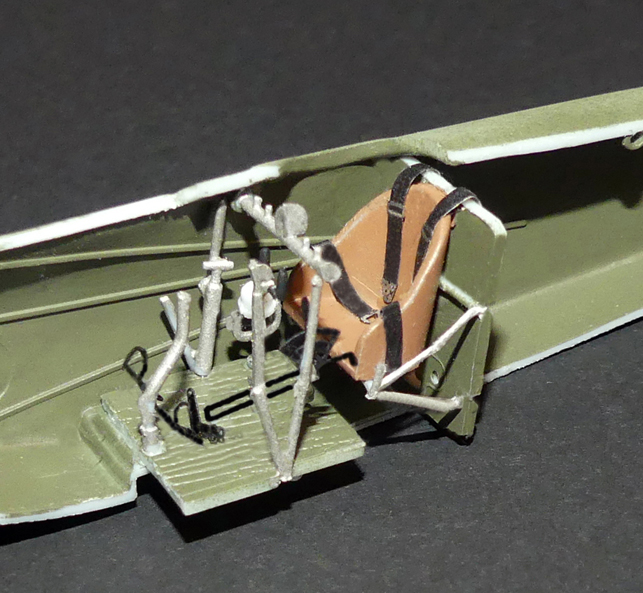
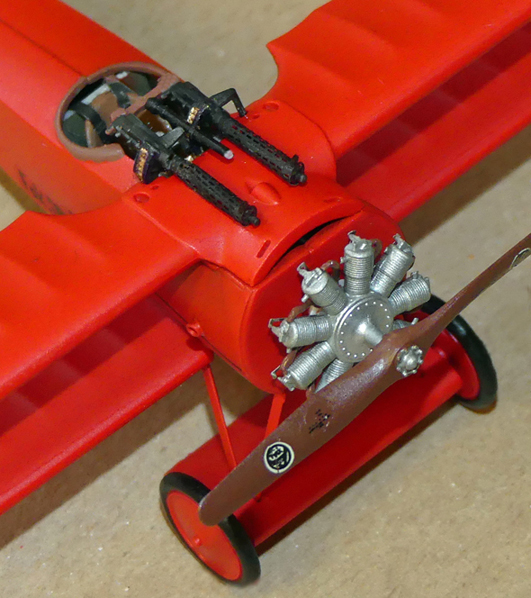
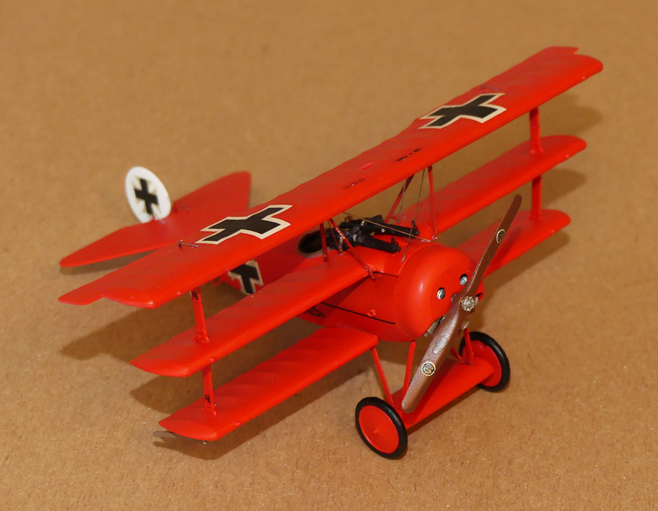
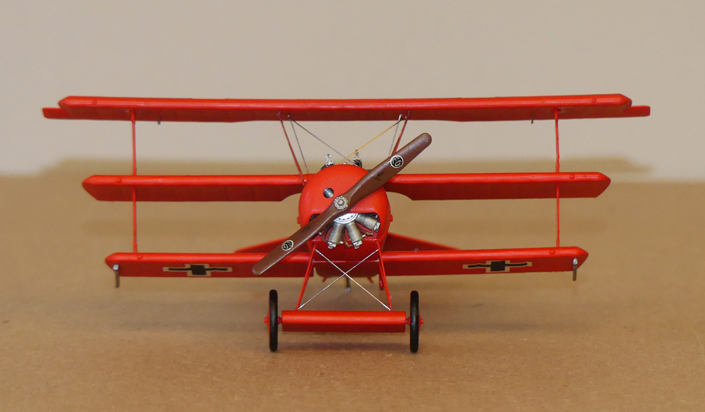


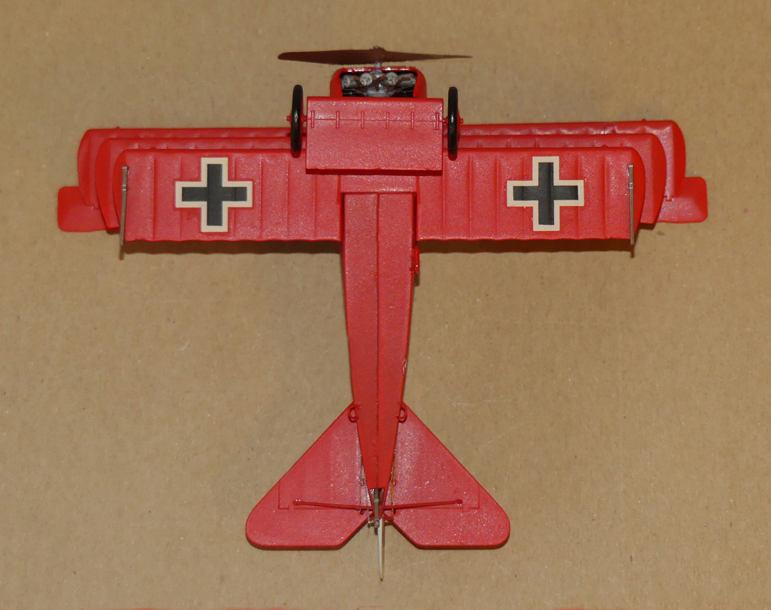

Here’s “Snoopy Vs. The Red Baron” by the Guardsmen from 1965: Video.